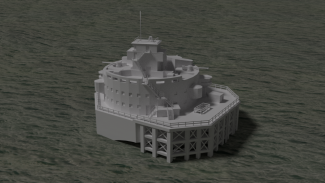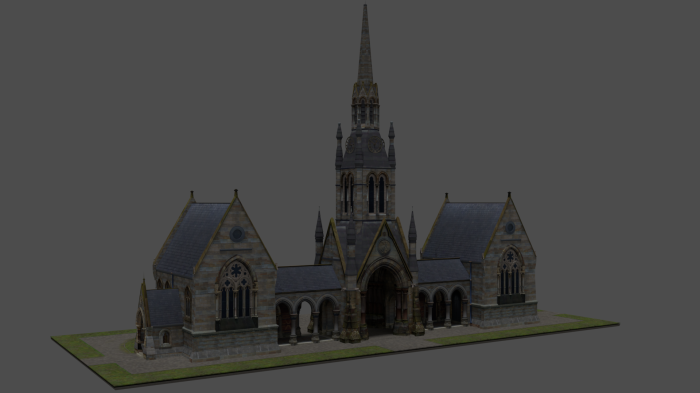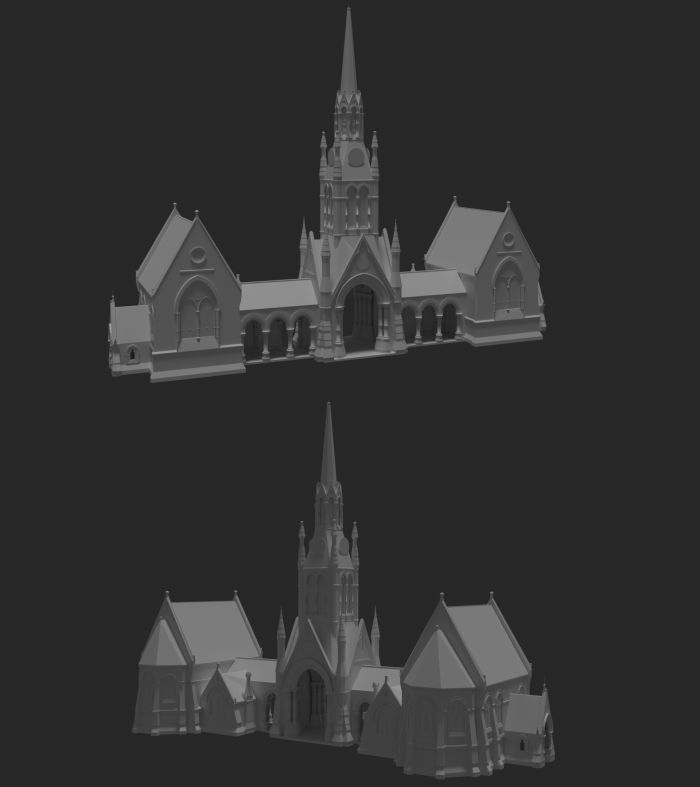Victory in Europe 75th anniversary- The 8th-10th May 2020 is a time to reflect and commemorate the enormous sacrifices made during the Second World War.
Read more on the East Riding Archives blog: Remembering VE Day: 75th Anniversary

Personal blog on Heritage, 3D, Archives, Local History, Outreach & Digital Engagement
Victory in Europe 75th anniversary- The 8th-10th May 2020 is a time to reflect and commemorate the enormous sacrifices made during the Second World War.
Read more on the East Riding Archives blog: Remembering VE Day: 75th Anniversary

Bull Sand Fort is one of my personal favourite architectural gems (which is unusual as I have a leaning towards gothic architecture) and it has a very evocative and mysterious presence in the Humber Estuary. It sits on a sand bank near Spurn Point (see my 3D model of the lighthouse) and the smaller island fort of Haile Sand.

Bull Sand Fort was built during the First World War to protect the ports located further up the estuary and was officially completed in December 1919.
Both of the forts were often under attack from aircraft and submarines. As of 1987 the fort was given Grade II listed status.
This artistic representation of the fort depicts as it was during the period of the Second World War, with the enhanced gun emplacements at roof level.
The fort contained accommodation for a garrison of 200 including sleeping quarters, stores for beer and coal, a kitchen and boiler rooms.
Although not necessarily true to life of the real Humber Estuary, I modelled the water with some level of translucency so the submerged features of the fort can be seen. The structure was modelled using photographs as a reference and the creation of texture UV maps in Adobe Photoshop. Original plans of the fort dating from 1917 can be consulted in the East Riding Archives, archive reference DDX1200/3/2 and are really interesting historical documents.
For a more in-depth history of this fascinating structure please see this informative account from the Island of Hope website.

This model has taken awhile due to many work commitments and has been an ongoing personal project, but here it finally is:
King Henry VIII’s “Hull Castle” was built c.1541 as an artillery castle. The central castle structure is attached to two trefoil-shaped blockhouses with curtain walls that span alongside the east bank of the River Hull. The most southern blockhouse, situated where the River Hull and Humber meet, was later incorporated into what became known as The Citadel in c.1680. What remained of Hull Castle was demolished in 1863.
I first mentioned this project back in an April- Hollar’s Hull in 3D: Part I– and have modelled some extra scenery features since then. This project was inspired by Wenceslaus Hollar’s map of Kingston upon Hull dating from c.1642. To recreate the entire map would be a mammoth task, so I’ve focused on the top section featuring King Henry VIII’s “Hull Castle”.


Beverley Gate also features on Hollar’s map and I had previously created a model which I might integrate in the future:

As an early Christmas present you can now watch some of the presentations from the ‘Discovering Collections Discovering Communities’ conference online- see the full selection here http://dcdcconference.com/dcdc17-papers/
DCDC17 was held at The Lowry in Salford on the 27th-29th November 2017. My thanks go to the conference hosts, The National Archives and Research Libraries UK, for such an inspiring event. It was a great privilege to present alongside experts in their fields on the big Lowry stage from the archive, library, museums and academic sectors.
My talk (see video above) ‘Archives in 3D: A multidisciplinary approach to digital engagement’ focused on a series of DIY 3D modelling workshops inspired by our collections at the East Riding Archives. Presenting in my work capacity as an Archives Assistant, I spoke about workshop delivery and the practicalities and impact of combining archives with 3D. The workshops were a great opportunity to take part in the Hull City of Culture year. Two of the workshops were official Hull City of Culture events where we focused on recreating the lost, built heritage of Hull as a method of educating and engaging audiences with their local heritage using a creative medium.
Summary
Looking and learning from archivist Hannah Rice at East Riding, Cambridge has huge potential to combine archives with 3-D.
I was following the hashtag #DCDC17 where the great and the good from the archives community seemed to be. I confess that it’s only in recent times that I’ve become interested in archives – in part because it took so long for me to get my head around how to actually use them properly.
Archives are complicated creatures
I use that term deliberately – for *archives* are living and breathing institutions that have the archivists as their beating hearts and buzzing brains that make them function. It’s easy to dismiss or stereotype archivists as people who don’t like to be disturbed/don’t like daylight/don’t like human contact – you’ve seen it in a movie somewhere. This is why I think it’s a dangerous thing to go about cutting funding for our…
View original post 990 more words
I’m really excited to be presenting at this year’s ‘Discovering Collections, Discovering Communities‘ (DCDC) conference. This year’s theme looks at the cultural value of collections and the creative economy, covering topics such as:
I will be speaking within my capacity as Archives Assistant with the East Riding Archives to talk about our Archives in 3D workshops.
Here’s my synopsis for ‘Archives in 3D: A multidisciplinary approach to digital engagement’ :
In celebration of Hull City of Culture 2017, ‘Archives in 3D’ were a series of practical 3D modelling workshops at the East Riding Archives combining digital techniques, interpretation skills, architectural history and the creative reuse of collections. These workshops were an opportunity for participants to recreate Hull and East Riding built heritage whilst learning how to use collections to inspire and inform their own historical reconstructions. This presentation will explore the lessons learned, practicalities and impact of a multidisciplinary approach to digital engagement.
DCDC17 will be held at The Lowry, Salford from 27-29 Nov 2017 and registration will close on October 31st. You can purchase tickets via the DCDC website. #DCDC17
DCDC is managed by Research Libraries UK and The National Archives.
This lighthouse located at Spurn Point (East Riding of Yorkshire) was built in c.1895 using the designs of Cornish engineer Thomas Matthews. It stands 39m high and is made of brick and rests on concrete foundations. The lighthouse is currently one of two at the site,
The lighthouse is currently one of two at the site, however, there have been several previous lighthouses, with the first one being built c.1427. The light was discontinued in 1985 and underwent restoration in 2015.

The inspiration to recreate Spurn Point’s current high lighthouse came from my own ancestral tourism trip where I was researching the once-home of my 3xgreat-grandparents.
My 3xgreat-grandfather, William Bacchus, and his wife Sarah Ann (3xgreat-grandmother) used to live on Spurn Point itself whilst he was a lifeboat man from 1877-1891 (with a two-year break from 1883-1885). During this time, my 2xgreat-grandmother Lavinia was born in 1879, along with sister Sarah Jane in 1882, and they lived in the lifeboat men’s houses overlooking the two older lighthouses.

“Thompson’s Folly” was built in 1825 by Thomas Thompson within the grounds of his grand castellated house, Cottingham Castle near Hull. Built as a prospect tower, it stands on the highest point of the estate which at present is the grounds of Castle Hill Hospital.
Cottingham Castle was left as a derelict site after Thompson’s death in 1828 and a subsequent fire in May 1861. The folly is in the octagonal tower form featuring neo-gothic windows and is two-storeys tall. The style highly resembles Cottingham Castle itself- perhaps another future project!

I recently wrote a guest blog post for Sketchfab on my methods for recreating built heritage using archives, Blender 3D software and some heritage interpretation. Many thanks to the Sketchfab Cultural Heritage Lead Tom Flynn and the team! 🙂
You can read my post on the Cultural Heritage section of Sketchfab: Bringing Built Heritage to (Digital) Life
I’ve been wanting to create a model of this Gothic-revival building for years and finally got around to create one based on my own photographs. Bridlington Cemetery Chapel (as mentioned in one of my old posts) is a Grade II listed building located in Bridlington’s main cemetery off Sewerby Road.

The architect is Alfred Smith of Nottingham and on the front pediment is the date 1879 carved in the stone. It is a beautiful, symmetrical structure in the Victorian Gothic style that has an imposing presence over the cemetery. At the rear, some of the windows are unfortunately boarded up (as of April 2017 when I photographed the building), and so within my model I have replicated the decorated tracery that you can see on the front wings as this would have been the most likely scheme.

I particularly like the symmetrical nature of the structure with the arcades and central tower. For a potential future development, I may consider modelling some of the chapel’s surrounding graveyard to include some foliage and gravestones. This cemetery includes some lovely sculptural headstones which would be a particular challenge to model, but would really place this building within its wider context. This model of Bridlington Cemetery Chapel is a personal project and was created using my own photographs and Blender3D software.